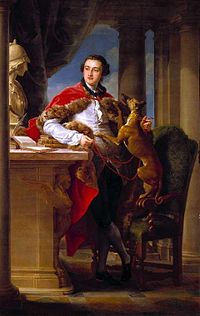- Charles Compton, 7th Earl of Northampton
-
 Charles Compton, 7th Earl of Northampton (1737–1763) by Pompeo Batoni (1708–1787), painted in Rome, 1758. Oil on canvas; Cambridge, Fitzwilliam Museum
Charles Compton, 7th Earl of Northampton (1737–1763) by Pompeo Batoni (1708–1787), painted in Rome, 1758. Oil on canvas; Cambridge, Fitzwilliam Museum
Charles Compton, 7th Earl of Northampton, DL (22 July 1737 – 18 October 1763)[1] was a British peer and diplomat.
He was the eldest son of Hon. Charles Compton, in turn youngest son of George Compton, 4th Earl of Northampton, and his wife Mary, only daughter of Sir Berkeley Lucy, 3rd Baronet.[2] Compton was educated at Westminster School and went then to Christ Church, Oxford.[3] In 1758, he succeeded his uncle George Compton as earl and was elected Recorder of Northampton.[4] He received a Doctor of Civil Law by the University of Oxford in the following year and was nominated a Deputy Lieutenant for the county of Northamptonshire.[3]
In 1761, during the coronation of King George IV of the United Kingdom, Compton was the Bearer of the Ivory Rod with the Dove.[3] Subsequently he was appointed Ambassador Extraordinary and Plenipotentiary to the Rupublic of Venice with his introduction in May 1763, died only few months later.[3]
On 13 September 1759, he married Lady Ann Somerset, eldest daughter of Charles Somerset, 4th Duke of Beaufort.[5] Their only child Elizabeth married George Cavendish, 1st Earl of Burlington.[5] His wife died at Naples in May 1763 and Compton survived her until October, aged only 26.[4] Both were buried in the family's vault in Compton, Northamptonshire.[4] He was succeeded in the earldom by his younger brother Spencer.[6]
References
- ^ "Leigh Rayment - Peerage". http://www.leighrayment.com/peers/peersN2.htm. Retrieved 2 November 2009.
- ^ Burke, John (1832). A Genealogical and Heraldic History of the Peerage and Baronetage of the British Empire. vol. II (4th ed.). London: Henry Colburn and Richard Bentley. pp. 237.
- ^ a b c d Doyle, James Edmund (1886). The Official Baronage of England. vol. II. London: Longmans, Green & Co.. pp. 629.
- ^ a b c Collins, Arthur (1812). Sir Egerton Brydges. ed. Collin's Peerage of England. vol. III. London: T. Bensley. pp. 262–263.
- ^ a b Debrett, John (1828). Debrett's Peerage of the United Kingdom of Great Britain and Ireland. vol. I (17th ed.). London: G. Woodfall. pp. 74.
- ^ "ThePeerage - Charles Compton, 7th Earl of Northampton". http://www.thepeerage.com/p1022.htm#i10212. Retrieved 10 April 2007.
Diplomatic posts Preceded by
John Murray
as Minister ResidentAmbassador Extraordinary and Plenipotentiary
to the Republic of Venice
1762 – 1763Succeeded by
James Wright
as Minister ResidentPeerage of England Preceded by
George ComptonEarl of Northampton
5th creation
1758 – 1763Succeeded by
Spencer ComptonCategories:- 1737 births
- 1763 deaths
- Alumni of Christ Church, Oxford
- Deputy Lieutenants of Northamptonshire
- Earls in the Peerage of England
- Earls of Northampton (1618)
- Compton family
- Old Westminsters
- Ambassadors of Great Britain to the Republic of Venice
Wikimedia Foundation. 2010.
